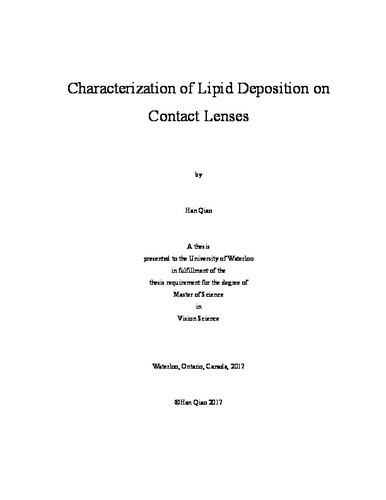| dc.contributor.author | Qiao, Han | |
| dc.date.accessioned | 2017-08-30 18:18:21 (GMT) | |
| dc.date.available | 2017-08-30 18:18:21 (GMT) | |
| dc.date.issued | 2017-08-30 | |
| dc.date.submitted | 2017-08-28 | |
| dc.identifier.uri | http://hdl.handle.net/10012/12277 | |
| dc.description.abstract | The purpose of this thesis was to evaluate the influence of lipid deposition on silicone hydrogel contact lens materials and to construct an in vitro platform to further explore the effect of lipid interaction with contact lenses under physiologically relevant conditions. In Chapter 3, the location of fluorescently tagged cholesteryl ester deposition was evaluated on four silicone hydrogel lens materials after simulated contact lens wear with a vial model for 1 day, 14 days and 30 days, using a CLSM technique. In Chapter 4, the design and implementation of a blink mechanism on an in vitro eye model was outlined. In Chapter 5, the design and implementation of a tear film onto an in vitro eye model was outlined. In Chapter 6, the non-invasive tear film break-up time of two silicone hydrogels were evaluated after simulated contact lens wear with an in vitro eye model. In Chapter 7, the limitations and future directions of the in vitro eye model was outlined. Overall, the amount of accumulated cholesteryl ester in silicone hydrogels increased with prolonged incubation periods. The level of surface versus bulk cholesteryl ester deposition varied with lens material depending upon their surface and bulk properties. A blink mechanism and tear film structure were established on the in vitro eye model, allowing physiological simulations of tear volume, tear flow, intermittent air exposure, and mechanical wear. Non-invasive tear break-up time of the pre-lens tear film on silicone hydrogels was successfully measured for lotrafilcon B, which presented values that were comparable to clinical tear break-up times. This thesis reported a complex relationship between lipid deposition on silicone hydrogels and detailed the developments of a physiologically relevant in vitro eye model to move towards a better understanding of the effect of lipid deposition on contact lens discomfort. | en |
| dc.language.iso | en | en |
| dc.publisher | University of Waterloo | en |
| dc.subject | Contact Lens | en |
| dc.subject | Lipid | en |
| dc.subject | Silicone Hydrogel | en |
| dc.subject | Contact Lens Deposition | en |
| dc.subject | Confocal Microscopy | en |
| dc.subject | Eye Model | en |
| dc.title | Characterization of Lipid Deposition on Contact Lenses | en |
| dc.type | Master Thesis | en |
| dc.pending | false | |
| uws-etd.degree.department | School of Optometry and Vision Science | en |
| uws-etd.degree.discipline | Vision Science | en |
| uws-etd.degree.grantor | University of Waterloo | en |
| uws-etd.degree | Master of Science | en |
| uws.contributor.advisor | Lyndon, Jones | |
| uws.contributor.advisor | Lakshman, Subbaraman | |
| uws.contributor.affiliation1 | Faculty of Science | en |
| uws.published.city | Waterloo | en |
| uws.published.country | Canada | en |
| uws.published.province | Ontario | en |
| uws.typeOfResource | Text | en |
| uws.peerReviewStatus | Unreviewed | en |
| uws.scholarLevel | Graduate | en |

